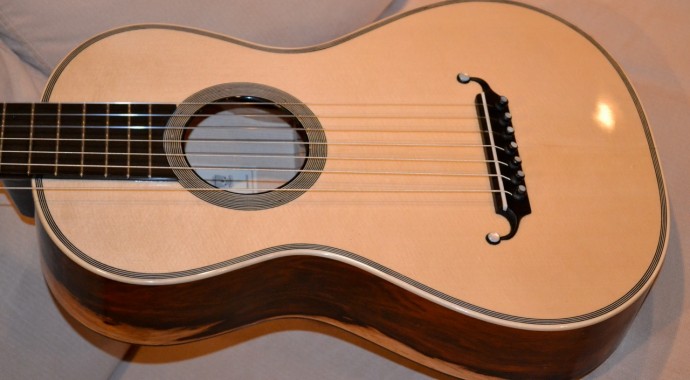Purchasing a guitar, especially in the early stages of a playing career is incredibly daunting. The sheer volume of options available to you is hard to comprehend and more so add to the confusion than provide convenience.
When a novice guitarist or the parent of an enthusiastic new guitar student sets out to weed through the magazines and marketing, they’re often drawn to the cheaper price tags of beginner and “economy” guitars. Sometimes these instruments come in neatly packed boxes with everything you need to get started. Cable, small amplifier, strap and sometimes even a tuner are all included, along with an abysmally low price tag. All this inevitably draws the initial approval and consideration of the bargain-hunting consumer.
Even within the ranks of quality instruments, you have entire brands and lines of guitars dedicated to the “economy” shopper. With significant price cuts, these guitars attract the eye of parents and players who aren’t sure if the guitar will “stick” as a hobby, or just fall to the wayside after a couple of months. The reasoning is understandable; however it’s worth considering that guitars in the economy category aren’t made to last or to play with any quality feel or sound.

The problem then becomes a self fulfilling prophecy. The aspiring guitarist owns a poor quality guitar, thus is quicker to lose sight of true appeal offered by the instrument and eventually gives it up altogether.
Spending a Little Extra
These guitars truly are not worth the money, even in the context of getting something for a beginner. The quality hit you take when going from a Fender to a Squier for example isn’t worth the mere $150 you’ll save in the process. If the hobby sticks, you’ll then end up having to get another guitar very quickly.
Spending a little extra money and getting a genuinely decent instrument provides a better long-term outlook, and will offer up a more genuine experience than a cheaper economy guitar would offer. In fact some of the best guitars are the middle-of-the-road options, and with prices well under the $1000 mark, you’re still getting a good deal.
Price Difference
The other reason to go the extra mile and get the better quality instrument is that the actual price difference isn’t terribly high. A few examples would be the following:
The Squier Strat verses the Fender Standard Strat
The Squier strats will run you about $350-$400, which is pricey for a Fender knock-off. You can have the real deal for around $500-$600, which is a solid price for a quality instrument that has been around for along time.
Ibanez GRG Series verses the Ibanez S Series
The GRG lineup is on the cheaper end of the Ibanez guitar spectrum and will run you somewhere near $200-$300. It sounds tempting, but these guitars aren’t as nice as the higher end Ibanez instruments and won’t be satisfying to a serious player. If you’re willing to go to the $500-$700 mark, the S series (created with the help of Joe Satriani) has several excellent, high quality guitars at this price level.
Dean Acoustics versus Taylor Acoustics
Again, you’re dealing with the same story. The Dean options are generally cheaper however they’re not as well made as their Taylor counter parts. Even though the Dean instruments can be had for $200, going with a $500-$700 Taylor is enough of a jump in quality to more than justify the extra expense.
As a general rule, when you pay less than $400 for a guitar, you’re taking a huge hit in quality. Whether or not it’s worth an extra $200-$300 to get something of value is a matter of situation and opinion. My honest opinion is that it is worth it, and that buying a guitar that you’ll end up throwing away in a couple years (or sell for next to nothing), isn’t worth the money. By the time you’ve replaced that guitar, you’ll have spent $600 anyway.
Some Exceptions to the Rule
Now not all guitars that fall under the “economy” tagline are bad news. In fact, there are two particularly good options you have in this regard:
Paul Reed Smith SE Series
Unlike their more expensive counterparts, the PRS SE guitars are notmade here in the states. However they are still some of the best guitars you can buy for the money in terms of sound and feel. They’re truly a lot of guitar for what you pay, and they can be had for anywhere from $400 to $900 depending on your budget.
Epiphone Les Pauls and SGs
Epiphone is to Gibson what Squier is to Fender, though there is a huge difference in the quality ratio. Epiphone guitars are actually very similar in quality to a true Gibson. Most people I’ve spoken with who have played both can’t tell a difference, and I would echo that sentiment. For around $500-$700 they’re a great option for a guitarist at any level.
Conclusion
Now to some, the break you get going from $600 to $300 might be all that matters, and if it is, that’s fine. Yet for those of you who feel a genuine interest in the guitar as an instrument, I believe you would be doing yourself a disservice to purchase a guitar without at least a modest amount of quality in terms of sound, look and feel. A cheap guitar might be easier on the pocket book, but they’re hard to redeem in terms of your playing experience. They simply don’t do the instrument justice.
Spend the extra money, and get something that will play well and that can last from early guitar lessons, well into a seasoned playing career.
Mood Media delivers in-store media marketing solutions, complete with customized music for business. Hillary Cates is an independent writer, specializing in the merging of cutting-edge technology and marketing.

